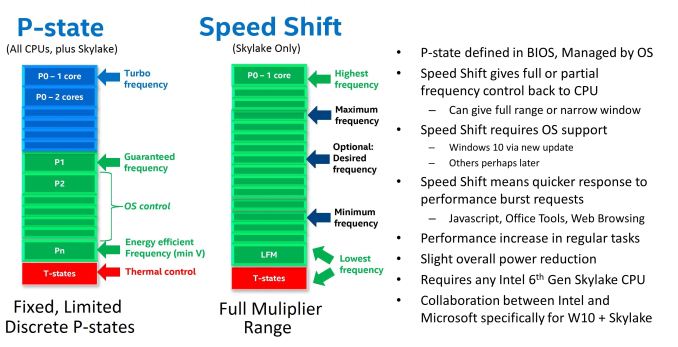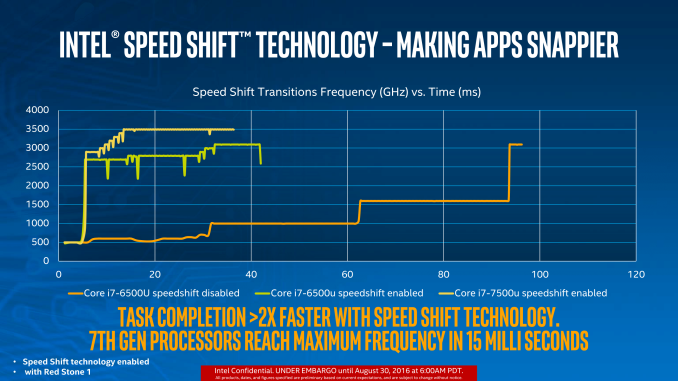The Intel Core i3-7350K (60W) Review: Almost a Core i7-2600K
by Ian Cutress on February 3, 2017 8:00 AM EST7th Generation New Features
One of the big questions regarding the launch of Intel’s 7th Generation of CPUs was around what extra features the new platform brings, especially if there isn’t any clock-for-clock performance improvement. As with our other Kaby Lake reviews, here we explain the main two: Speed Shift v2 and Optane Memory support.
Speed Shift v2
For the Intel’s 6th Generation of processors, Skylake, they introduced Speed Shift (v1). This was a feature that, at a high level, gave control of the voltage/frequency curve from the operating system to the processor. Using a series of internal metrics, such as instruction analysis and frequency, the CPU would automatically adjust the voltage and frequency of the processor as required. This afforded two major benefits: one, with the CPU in control it has access to many more points on the curve compared to the OS which is limited to specific P-states on the processor.
The second benefit is the speed of transition. A processor that can ramp up to a high frequency quickly and then drop down as needed can get through instructions quicker but also save power. Imagine driving a car, and having to wait 60 seconds to change a gear – it’s that sort of analogy.
What Speed Shift v2 does in the Kaby Lake family, compared to v1 in Skylake, is manage those transitions to higher frequency faster. Before Speed Shift, transitions from idle to peak turbo were on the order of 100 milliseconds, and Speed Shift v1 took that to 30 milliseconds (with a good base established within 15). Speed Shift v2 means that peak performance from idle now happens in 10-15 milliseconds total. This means that interactions with the OS, such as touch, or actions that rely on low latency, can occur within a couple of frames on a 60 Hz display.
The benefit of Speed Shift lies a lot in touch devices, which perhaps doesn’t affect the desktop Kaby Lake processors in this review, but also in web interactions. A lot of web work is stop and start, such as scrolling or javascript functions.
There is one caveat however – Speed Shift currently only works in Windows 10. It requires a driver which is automatically in the OS (v2 doesn’t need a new driver, it’s more a hardware update), but this limitation does mean that Linux and macOS do not benefit from it. I would be hard pressed to not imagine that Apple and Intel were not working on a macOS driver, but as yet we have not had confirmation that one exists.
Optane Memory Support
The latest memory technology to hit prime time is Intel and Micron’s 3D XPoint. This is a non-volatile form of data storage that is bit addressable and can be used as DRAM or storage. Despite being at least a decade in the making, and being formally announced in 2014, it is still yet to show up commercially as it is still being developed. Intel plans to create 3D XPoint DRAM that is slightly slower than normal DRAM but both denser (more of it) and non-volatile (keeps the data after power loss, saves power altogether), as well as 3D XPoint Storage that is faster than standard NAND flash, and more configurable. It the scheme of things, we expect the storage based products to hit the market first.
Intel, as far as we can tell, is set to release two main classes of product: Optane DRAM to be pin-compatible with DDR4 and require Optane DRAM enabled processors, and Optane SSDs which should work with any PCIe storage interface. ‘Optane Memory’ however, is something a little different. Based on pre-briefings, Optane Memory is certainly not Optane SSD we were told, but rather a storage cache for mechanical hard-drives. We’ve had this before with NAND flash drives, using Intel’s Rapid Storage Technology, and it seems that Kaby Lake and 200-series chipsets will support a new version of RST for PCIe based storage. But because this is caching drive, such as the 16GB Optane Memory drives in Lenovo’s upcoming notebooks, and not Optane SSD, might lead us to believe that ‘Optane Memory’ drives are not designed to be directly user addressable.
All that being said, Intel has stated that Optane Memory standalone drives should hit the market nearer Q3 for general consumer use, which is more in-line with what we might expect to see with Optane SSDs in the enterprise space.













186 Comments
View All Comments
JordanV - Tuesday, February 14, 2017 - link
I think the sales argument for the big Intel chips as video encoders has been for x264 where the faster NVENC, VCE, and QuickSync technologies offer lower quality at a given bitrate for higher quality x264 settings. For most people, the hardware encoders are enough but for many others, the quality is not sufficient.The quality difference between hardware and software HEVC is smaller with higher quality software h265 encodes beating the quality of your Pascal x265 encodes but with a big performance penalty. It's not worth it for most people, but if you have limited bitrate/storage and want the best quality, it might be.
HerrKaLeun - Friday, February 3, 2017 - link
Thanks for the great review, Ian.Considering one needs an expensive Z-board to OC, for most people buying an i5 makes more sense.
I don't understand why so many people complain about Intel allegedly not making enough progress. Now you get a dual-core that comes close (or even exceeds in single threaded benches) to the former flagship quadcore. If you want to have a CPU that vastly exceeds the "old" quadcore, Intel also has newer quadcores. It is not like the i3 is the end of the lineup.... For the $317 that the 2600k used to cost you can get a KabyLake non-K i7, which sure vastly exceeds in performance (and much lower TDP). I assume someone who could afford an over $300 CPU 6 years ago can afford $300 now and upgrading to an i3 may not be what that person would do anyway. the trend goes to more cores.... most people here complain about Intel not offering mainstream hexa and octa cores... not sure why the same people allegedly are so eager to get dual-cores.
zodiacfml - Friday, February 3, 2017 - link
Dual core is too weak for me. Web browsing can use more cores.Hulk - Friday, February 3, 2017 - link
Sorry to be dense.What does 2+2, 4+2, 4+3/e mean?
babysam - Saturday, February 4, 2017 - link
The first number refers to the number of CPU cores. Te second number refers to the IGP configuration (the number of shaders, which may be a little bit different across generations, e.g. Haswell GT3 has 40 shaders, while Broadwell/Skylake GT3 have 48 shaders).The extra e means there is an extra eDRAM cache (Crystalwell) on the CPU package.
Hulk - Saturday, February 4, 2017 - link
Thanks.AndrewJacksonZA - Saturday, February 4, 2017 - link
Thank you babysam.babysam - Saturday, February 4, 2017 - link
Thank you for you article (especially when many of us are waiting on the information of new CPU of both AMD and Intel). It is always good to have something to play (overclocked) with, but this is a little bit expensive.When I read the analysis of the first page, I see the lack of information on the CPU die size and transistor count disclosed by Intel recently. Also, I feel strange that the effect of the change of the 32nm to 22nm (from Haswell to Broadwell) have such a large difference on the 2C+GT2(which Intel claims there is a 37% reduction of the die, which can be seen in the table) and the 4C+GT3(which the difference are much smaller) CPU die. I feel even stranger when I see the Skylake 4C+GT3e die is a bit smaller than the Broadwell 4c+GT3e die. So I am quite curious on the sources of the die estimate.
P.S. I found the origin of the 234mm^2 of the Skylake die size estimate.
https://techreport.com/forums/viewtopic.php?t=1177...
which based on the images of the following
http://www.anandtech.com/show/10281/intel-adds-cry...
It seems that the die described is the Skylake-H(which is a 4C+GT4e configuration). This makes the 241.5mm^2 estimate of the Broadwell 4C+GT3e a little bit unrealistic (Skylake GT4e have 72 shaders, while Broadwell GT3e have 48 only)
babysam - Saturday, February 4, 2017 - link
Just find the die size of the Broadwell-H (4C+3e) in this documenthttp://www.intel.com/content/www/us/en/embedded/pr...
According to the document, the die size of Broadwell-H (4C+GT3e) should be 13.7mmx12.3mm = 168.51mm^2
(Many thanks for the hints: https://forums.anandtech.com/threads/broadwell-cor... , which the got the answer two years ago.)
WoodyBL - Saturday, February 4, 2017 - link
Am I the only one noticing that the i5-4690 was beating the i5-7600k in a lot of benchmarks? I'm having a hard time processing how that was even possible...